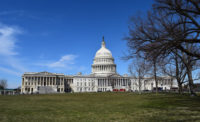
Pictured
L-R at ASA’s May 2011 Legislative Fly-In are: Dan Hilton, ASA Director of
Government Affairs, Tom LaGuardia, Milwaukee Valve, Dave Prahler, First Supply,
Congressman Paul Ryan (WI-1), Joe Poehling, First Supply.
By Dan Hilton,
ASA Director of Government Affairs
The dog days of summer may be ending, but things continue to heat up here in the nation’s capital. Millions of Americans watched with frustration while Congress worked to strike an 11th-hour deal to avoid defaulting on our country’s financial obligations. Seeing the dangers in defaulting on our commitments, ASA joined other industry leaders in urging Congress to lift the debt ceiling.
The results of that deal include reduced spending by $1.2 trillion over the course of 10 years, and appointing a so-called “super-committee” of the House and Senate to find an additional $1.5 trillion over 10 years or risk automatic cuts in both security and non-security spending. In order to avoid painful cuts to programs as politically vital as defense and Medicare, the committee is required to draft legislation identifying its own spending programs where cuts can be made.1 The committee has until Nov. 23, 2011, to report on legislation and until Dec. 23 of this year to pass the cuts into law, or the automatic cuts enacted in this summer’s debt deal are set to take hold.
Inside the Beltway, there are mixed feelings about the success of this super-committee. While the existing law prescribes that such cuts be made, it is more than a period of 10 years, which means future Congresses can overturn any of the cuts currently in law. In addition to the threat imposed by a future Congress or Administration, the super-committee should also be expected to face a number of jurisdictional or turf battles.
It is important to keep in mind that it isn’t always the worst performing programs that get cut; it is the programs with the weakest constituencies. The members of the super-committee can expect to be inundated by special interests from across the spectrum articulating their programs’ value to the taxpayer. ASA will assuredly be taking part in this process by educating members of the merits of LIFO and WaterSense.
Aside from Congress’ activity, or lack thereof, the Obama Administration has been working hard to implement a number of high-profile laws, the Patient Protection and Affordable Care Act (PPACA) being most prominent. Within this law are two areas the ASA is working to undo, in particular, the Employer Mandate and the Health Insurance Tax (HIT). As part of the Employer Mandate Working Group, we are advocating a repeal of this one-size-fits all, onerous mandate that punishes small businesses that don’t offer government-prescribed health insurance. If a business does not provide insurance, and if one or more employees receive subsidies to take part in the yet-to-be-created insurance exchange, the business will pay $2,000 per employee. If a business does provide insurance, like most ASA members do, and if one or more employees decide they would rather get their insurance through the exchange, they will pay $3,000 per subsidized employee.
The Health Insurance Tax is expected to be levied not on business owners directly, but on their insurance carrier. Health insurance companies will pay an aggregate annual fee of $8.0 billion in calendar year 2014. This will increase to $11.3 billion in 2015 and 2016, and eventually reach $14.3 billion by 2018. As it is widely assumed that health insurance costs will not be going down, and in fact will be rising, ASA is working with others to repeal this costly tax on small businesses. It is actions such as these that continue to set the tone of uncertainty that is stifling business and slowing our recovery.
For more information on ASA’s advocacy efforts and what you can do to promote positive change in Washington, please contact ASA Director of Government Affairs Dan Hilton at 703.328.5234 or atdhilton@asa.net.
1It is critical to remember that the goal is deficit reduction. That can be done in two ways, a reduction of spending and bringing in more tax revenue by making changes to the tax code.




